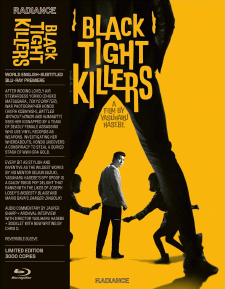Black Tight Killers (Blu-ray Review)

Director
Yasuharu HasebeRelease Date(s)
1966 (February 27, 2024)Studio(s)
Nikkatsu Corporation (Radiance Films)- Film/Program Grade: A-
- Video Grade: A-
- Audio Grade: A
- Extras Grade: B+
Review
Although, I’m sure, Yasuharu Hasebe’s Black Tight Killers (Ore no sawaru to abuzaize, or “If You Touch Me, Danger!” 1966) undoubtedly played Japanese-American theaters in the ‘60s in theaters catering to that community, it wasn’t until the late-1990s, when enterprising American Cinematheque programmers Chris D and Dennis Bartok conceived a series of festivals entitled “Outlaw Masters of Japanese Cinema” and included Hasebe’s feature. Memory is that Black Tight Killers must have been late in the festival, because the Japanese trailer was shown first, multiple times, and that trailer got a hugely enthusiastic reaction from the audience each time. When the feature itself was finally shown, audiences were not disappointed.
The film is a comic book-like action thriller, notable for its outrageous, colorfully staged, ludicrous and over-the-top story and action scenes. It was director Hasebe’s feature debut, promoted after years of training at Nikkatsu Studios. Every scene in the film is infused with his imagination.
The plot is almost immaterial to the visual design. Daisuke Honda (Nikkatsu star Akira Kobayashi) is a photojournalist returning from the Vietnam War—in a preview of things to come, all the explosions on the battlefield look like colorful fireworks. En route he meets Yuriko Sawanouchi (Chieko Matsubara), a stewardess.
Just as things seem to be heating up between them, she becomes the target of both Japanese gangsters in league with unsavory foreigners AND a half-dozen modern-day female ninjas, the black tight killers of the title. At first the ninjas, led mostly by Akiko (Akemi Kita), seem to want to kill the young lovers, but gradually it becomes clear they’re mainly after the gangsters, who are trying to get their hands on a chest full of gold stolen in Okinawa in the waning days of the war.
What makes Black Tight Killers so enjoyable is its earnest silliness and striking visual design. It’s not a comedy exactly, but it has the deadpan seriousness of a Naked Gun film no matter how outrageous it gets, like the leotard-wearing female ninjas’ go-go dancing and their use of “modern” techniques like spitting wads of chewing gum into their opponents’ eyes or throwing, instead of classic ninja shuriken (throwing stars), razor-sharp 45rpm records, or using a technique called “octopus pot.” As the girls are killed off one-by-one, composer Naozumi Yamamoto uses the same schmaltzy, sentimental musical cue to the point where it becomes comical. One tip-off is the casting of Bokuzen Hidari, Japanese cinema’s perennial funny-faced little old man, as a ninja master. At other times the picture brims with ereki, a musical genre hugely popular in Japan at the time, heavily influenced by The Ventures particularly.
Nearly every shot in every scene is ultra-stylized with bright primary color lighting—violet is a particular favorite—combined with the artifice of deliberately unreal moments, like the color-timed rear-screen projection used for driving scenes, or the schematic use of neon signage, making Black Tight Killers at times resemble a U.P.A. cartoon from the 1950s.
The cast, including many nameless foreign talent mostly in small roles, get into the spirit of the thing. The actresses playing the black-tighted killers seem to be enjoying their offbeat roles, and Akemi Kita is particularly good. Akira Kobayashi was at his peak here; in later years, he became something of a joke, bloated and sweaty, singing enka on Japanese TV shows, but he’s appealing here.
I think it was the late writer Bill Warren who, in referring to Japanese science fiction films, said those films were unsophisticated movies made by sophisticated filmmakers, an observation that could just as easily be applied to the same era’s chanbara, spy pictures, musicals, yakuza and crime films, including, emblematically in fact, Black Tight Killers. All this eye-candy is enormous fun yet…I do kind of wish western world video labels would try exploring the cache of richer, genuinely great Japanese cinema—the sophisticated movies made by sophisticated filmmakers—movies that lie just beneath the Ozu-Kurosawa-Mizoguchi masterpieces yet way above all these striking but still unambitious genre films even their directors were frequently a little embarrassed doing. While it’s great to see every last scrap of celluloid directed by, say, Seijun Suzuki, available in the west, it’s a crime so many others are completely or almost completely ignored. Why can’t we have more Blu-rays by directors like Tadashi Imai, Keisuke Kinoshita, Mikio Naruse, Yuzo Kawashima, Kinuyo Tanaka, So Yamamura, and Yoji Yamada?
Black Tight Killers turned up on DVD in the early years of that format, and while that DVD looked great for the time, Radiance’s Blu-ray of this Nikkatsuscope (2.35:1) production is a marked improvement, the label doing additional restoration work on Nikkatsu’s high-definition master. Detail is very good, and the colors—so essential—really “pop.” The Dolby mono audio is fine, and the English subtitles are particularly good. Region A/B encoded.
Extras consist of an excellent new audio commentary track by Japanese film historian Jasper Sharp; an archival interview with director Hasebe (who died in 2009) that, I think, is repurposed from the earlier DVD version; that crowd-pleasing trailer; and a full-color, 20-page booklet featuring a fine essay about the film by Chris D.
Even those who generally avoid older Japanese movies will likely find Black Tight Killers enormous fun. It’s a feast for the eyes and ears and Radiance’s Blu-ray does the film justice.
- Stuart Galbraith IV

